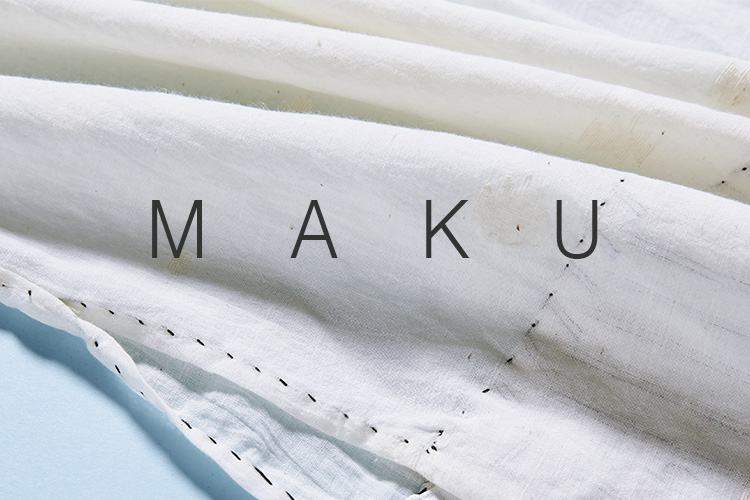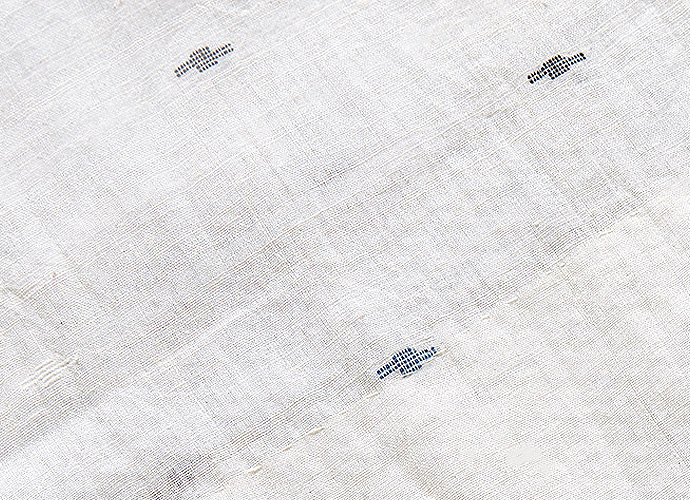

Maku – a conceptual fashion brand rooted in the philosophy of its founder director Santanu Das. A committed conceptual artist, Maku, for Santanu, is an extension of his artistic oeuvre.
The history of textile runs parallel to human civilization, a coded time machine reaching out to our emotions as a testimony of our heritage, culture and skill. At Maku the textile takes the front seat, the design statements evolving from the pulse of the yardage. The brand offers select exclusively designed garment from the fibre to the rack using only hand spun and hand woven textile in Indigo.
The promotion of a single colour, indigo as a colour of sustenance and a statement towards better future is a conscious and deliberate decision of the brand. Indigo the enigmatic dye has bewitched throughout history; its status symbol, its eclectic property, its’ negative history – especially in Bengal, the brands’ home state – has romanticized the dye in the eyes of the connoisseur. Maku uses this to its advantage, creating one of a kind garment exploring the dye showcasing the richness and versatility of the colour – from the palest powder blue to black. But for Maku, indigo extends beyond its colour as a weapon against consumerist pattern, yet Maku garments whisper, not scream, are intimate in character demanding your touch, smell, taste, feel to expound its comfort to you.

The label believes in the slow fashion of handloom and uses only organically produced textiles manufactured using indigenous practices – hand spun and hand woven – intrinsically bringing into focus India’s textile history of Khadi as an emblem of human skill and sensitivity towards material resources. In the individualistic spirit of the textile type it advocates – handloom, the brand deliberately incorporates perceived imperfection in its design detail through the use of reverse buttons, print etc.
The brand demands to be evaluated in the context of the tsunami of globalization of recent times. The open market policy comes with certain inherent flaws. Its’ characteristic of over consumption, consumerism, multiple choices and excessive competition breeds intolerance and fundamentalism; the trait seeping into the larger context of life style, social milieu and perspective. An experimental fashion brand, Maku is a silent revolution advocating the opposite by inciting ‘tolerance’ by limiting choice.

Globalization has brought about a demand for uniformity of product, which is totally alien to Indian textile history, seeped in Indian handloom. The global market imposes the parameters of machine made textile on handloom, controlling supply chain through segmentation and specialisation. As a brand Maku is sensitive to this and to irresponsible design demands that undermine traditional practices. Western design concepts blind us from looking deeper into the identity of the tradition; forcing weavers to translate alien visual ideas into textiles. This tendency has forced weavers to forget their traditional practices and inherent knowledge of a craft, threatening their very existence. Maku has tried to reduce this gap between designers and artisans. Maku designs are contextual to community, practices and individual skill sets. The brand works closely with Jamdani weaving clusters in West Bengal and is sensitive to the weaving history of its weaver community – technical and aesthetic. Designs are not developed in far removed air-conditioned studios in the cities rather in collaboration with artisans on their looms. Maku only handholds them giving shape to wearable art forms which appeal to global consumers, thus supporting expansion mode with limited diversification (limiting choice); in the process saluting age old practices and acknowledging weavers as artisans, not mere factory hands.

Maku – a conceptual fashion brand rooted in the philosophy of its founder director Santanu Das. A committed conceptual artist, Maku, for Santanu, is an extension of his artistic oeuvre.
The history of textile runs parallel to human civilization, a coded time machine reaching out to our emotions as a testimony of our heritage, culture and skill. At Maku the textile takes the front seat, the design statements evolving from the pulse of the yardage. The brand offers select exclusively designed garment from the fibre to the rack using only hand spun and hand woven textile in Indigo.


The promotion of a single colour, indigo as a colour of sustenance and a statement towards better future is a conscious and deliberate decision of the brand. Indigo the enigmatic dye has bewitched throughout history; its status symbol, its eclectic property, its’ negative history – especially in Bengal, the brands’ home state – has romanticized the dye in the eyes of the connoisseur. Maku uses this to its advantage, creating one of a kind garment exploring the dye showcasing the richness and versatility of the colour – from the palest powder blue to black. But for Maku, indigo extends beyond its colour as a weapon against consumerist pattern, yet Maku garments whisper, not scream, are intimate in character demanding your touch, smell, taste, feel to expound its comfort to you.


The label believes in the slow fashion of handloom and uses only organically produced textiles manufactured using indigenous practices – hand spun and hand woven – intrinsically bringing into focus India’s textile history of Khadi as an emblem of human skill and sensitivity towards material resources. In the individualistic spirit of the textile type it advocates – handloom, the brand deliberately incorporates perceived imperfection in its design detail through the use of reverse buttons, print etc.
The brand demands to be evaluated in the context of the tsunami of globalization of recent times. The open market policy comes with certain inherent flaws. Its’ characteristic of over consumption, consumerism, multiple choices and excessive competition breeds intolerance and fundamentalism; the trait seeping into the larger context of life style, social milieu and perspective. An experimental fashion brand, Maku is a silent revolution advocating the opposite by inciting ‘tolerance’ by limiting choice.


Globalization has brought about a demand for uniformity of product, which is totally alien to Indian textile history, seeped in Indian handloom. The global market imposes the parameters of machine made textile on handloom, controlling supply chain through segmentation and specialisation. As a brand Maku is sensitive to this and to irresponsible design demands that undermine traditional practices. Western design concepts blind us from looking deeper into the identity of the tradition; forcing weavers to translate alien visual ideas into textiles. This tendency has forced weavers to forget their traditional practices and inherent knowledge of a craft, threatening their very existence. Maku has tried to reduce this gap between designers and artisans. Maku designs are contextual to community, practices and individual skill sets. The brand works closely with Jamdani weaving clusters in West Bengal and is sensitive to the weaving history of its weaver community – technical and aesthetic. Designs are not developed in far removed air-conditioned studios in the cities rather in collaboration with artisans on their looms. Maku only handholds them giving shape to wearable art forms which appeal to global consumers, thus supporting expansion mode with limited diversification (limiting choice); in the process saluting age old practices and acknowledging weavers as artisans, not mere factory hands.


